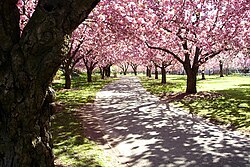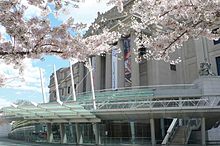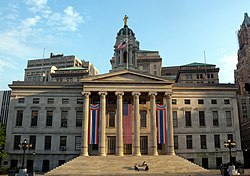Local periodicals
Brooklyn has several local newspapers: The Brooklyn Daily Eagle, Bay Currents (Oceanfront Brooklyn), Brooklyn View, The Brooklyn Paper, and Courier-Life Publications. Courier-Life Publications, owned by Rupert Murdoch's News Corporation, is Brooklyn's largest chain of newspapers. Brooklyn is also served by the major New York dailies, including The New York Times, the New York Daily News, and the New York Post.The borough is home to the bi-weekly cultural guide The L Magazine and the arts and politics monthly Brooklyn Rail, as well as the arts and cultural quarterly Cabinet. Hello Mr. is also published in Brooklyn.
Brooklyn Magazine is one of the few glossy magazines about Brooklyn. Several others, that are now defunct, include: BKLYN Magazine (a bimonthly lifestyle book owned by Joseph McCarthy, that saw itself as a vehicle for high-end advertisers in Manhattan and was mailed to 80,000 high-income households), Brooklyn Bridge Magazine, The Brooklynite (a free, glossy quarterly edited by Daniel Treiman), and NRG (edited by Gail Johnson and originally marketed as a local periodical for Clinton Hill and Fort Greene, but expanded in scope to become the self-proclaimed "Pulse of Brooklyn" and then the "Pulse of New York").[80]
Ethnic press
Brooklyn has a thriving ethnic press. El Diario La Prensa, the largest and oldest Spanish-language daily newspaper in the United States, maintains its corporate headquarters at 1 MetroTech Center in downtown Brooklyn.[81] Major ethnic publications include the Brooklyn-Queens Catholic paper The Tablet, Hamodia, an Orthodox Jewish daily and The Jewish Press, an Orthodox Jewish weekly. Many nationally distributed ethnic newspapers are based in Brooklyn. Over 60 ethnic groups, writing in 42 languages, publish some 300 non-English language magazines and newspapers in New York City. Among them the quarterly "L'Idea", a bilingual magazine printed in Italian and English since 1974. In addition, many newspapers published abroad, such as The Daily Gleaner and The Star of Jamaica, are available in Brooklyn.[citation needed] Our Time Press published weekly by DBG Media covers the Village of Brooklyn with a motto of "The Local paper with the Global View".Television
The City of New York has an official television station, run by the NYC Media Group, which features programming based in Brooklyn. Brooklyn Community Access Television is the borough's public access channel.[citation needed]Events
- The annual Coney Island Mermaid Parade (mid-to-late June) is a costume-and-float parade.[82]
- Coney Island also hosts the annual Nathan's Hot Dog Eating Contest (July 4).[82]
- The annual Labor Day Carnival (also known as the Labor Day Parade or West Indian Day Parade) takes place along Eastern Parkway in Crown Heights.
Parks and other attractions
See also: Tourism in New York City
Kwanzan Cherries in bloom at Brooklyn Botanic Garden.
- Brooklyn Botanic Garden: located adjacent to Prospect Park is the 52-acre (21 ha) botanical garden, which includes a cherry tree esplanade, a one-acre (0.4 ha) rose garden, a Japanese hill and pond garden, a fragrance garden, a water lily pond esplanade, several conservatories, a rock garden, a native flora garden, a bonsai tree collection, and children's gardens and discovery exhibits.
- Coney Island developed as a playground for the rich in the early 1900s, but it grew as one of America's first amusement grounds and attracted crowds from all over New York. The Cyclone rollercoaster, built in 1927, is on the National Register of Historic Places. The 1920 Wonder Wheel and other rides are still operational. Coney Island went into decline in the 1970s, but has undergone a renaissance.[83]
- Floyd Bennett Field: the first municipal airport in New York City and long closed for operations, is now part of the National Park System. Many of the historic hangars and runways are still extant. Nature trails and diverse habitats are found within the park, including salt marsh and a restored area of shortgrass prairie that was once widespread on the Hempstead Plains.
- Green-Wood Cemetery, founded by the social reformer Henry Evelyn Pierrepont[84] in 1838, is an early Rural cemetery. It is the burial ground of many notable New Yorkers.
- Jamaica Bay Wildlife Refuge: a unique Federal wildlife refuge straddling the Brooklyn-Queens border, part of Gateway National Recreation Area
- New York Transit Museum displays historical artifacts of Greater New York's subway, commuter rail, and bus systems; it is located at Court Street, a former Independent Subway System station in Brooklyn Heights on the Fulton Street Line.
- Prospect Park is a public park in central Brooklyn encompassing 585 acres (2.37 km2).[85] The park was designed by Frederick Law Olmsted and Calvert Vaux, who created Manhattan's Central Park. Attractions include the Long Meadow, a 90-acre (36 ha) meadow, the Picnic House, which houses offices and a hall that can accommodate parties with up to 175 guests; Litchfield Villa, Prospect Park Zoo, the Boathouse, housing a visitors center and the first urban Audubon Center;[86] Brooklyn's only lake, covering 60 acres (24 ha); the Prospect Park Bandshell that hosts free outdoor concerts in the summertime; and various sports and fitness activities including seven baseball fields. Prospect Park hosts a popular annual Halloween Parade.
Sports
Main article: Sports in Brooklyn
Barclays Center, located in Pacific Park within Prospect Heights, is Brooklyn's premier sports venue.
Brooklyn also has a storied sports history. It has been home to many famous sports figures such as Joe Paterno, Vince Lombardi, Mike Tyson, Joe Torre, and Vitas Gerulaitis. Basketball legend Michael Jordan was born in Brooklyn though he grew up in Wilmington, North Carolina.
In the earliest days of organized baseball, Brooklyn teams dominated the new game. The second recorded game of baseball was played near what is today Fort Greene Park on October 24, 1845. Brooklyn’s Excelsiors, Atlantics and Eckfords were the leading teams from the mid-1850s through the Civil War, and there were dozens of local teams with neighborhood league play, such as at Mapleton Oval.[87] During this "Brooklyn era", baseball evolved into the modern game: the first fastball, first changeup, first batting average, first triple play, first pro baseball player, first enclosed ballpark, first scorecard, first known African-American team, first black championship game, first road trip, first gambling scandal, and first eight pennant winners were all in or from Brooklyn.[88]
Brooklyn's most famous historical team, the Brooklyn Dodgers, named for "trolley dodgers" played at Ebbets Field.[89] In 1947 Jackie Robinson was hired by the Dodgers as the first African-American player in Major League Baseball in the modern era. In 1955, the Dodgers, perennial National League pennant winners, won the only World Series for Brooklyn against their rival New York Yankees. The event was marked by mass euphoria and celebrations. Just two years later, the Dodgers moved to Los Angeles. Walter O'Malley, the team's owner at the time, is still vilified, even by Brooklynites too young to remember the Dodgers as Brooklyn's ball club.
After a 43-year hiatus, professional baseball returned to the borough in 2001 with the Brooklyn Cyclones, a minor league team that plays in MCU Park in Coney Island. They are an affiliate of the New York Mets.
Brooklyn once had a National Football League team named the Brooklyn Lions in the 1920s, who played at Ebbets Field.
















